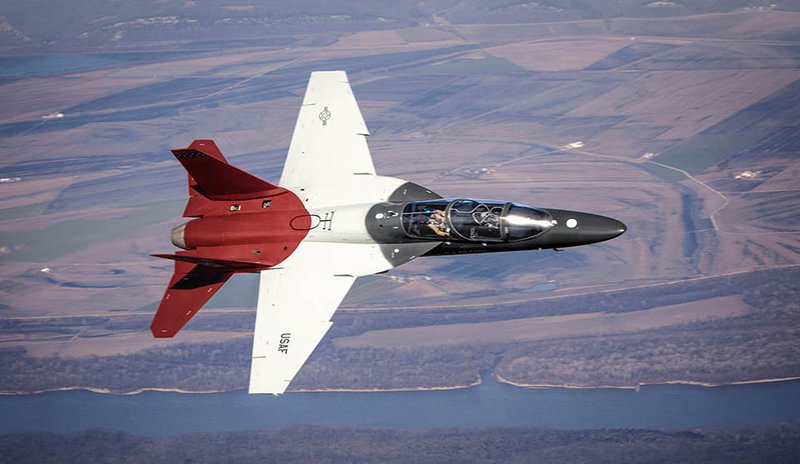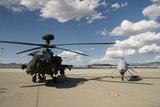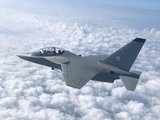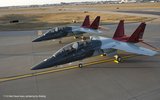T-45 Goshawk grounding puts more stress on US Navy pilot pipeline
The T-45’s track record is littered with incidents and pauses to training flight operations. (Photo: US DoD)
The USN's fleet of T-45C Goshawk trainer jets had to be grounded after a trainee experienced a low-pressure compressor blade failure before take-off on 11 October, US officials have admitted.
The USN initiated the safety stand-down on 14 October.
The aircraft are being used to train navy and USMC fighter pilots, so the unavailability of the Goshawk means that pilot training is taking a serious hit as well.
Rear Adm John Lemmon, the USN's PEO Tactical Aircraft Programs, said in a statement on 18 October that four commands 'have been working around the clock with industry partner Rolls-Royce to identify the root cause of the recent T-45 engine blade failure'.
He added: 'Engineering analysis has been under way and will continue until we can safely return the T-45 fleet to a flying status.'
In August, Rolls-Royce received a $1.01 billion indefinite-delivery contract from the Naval Air Systems Command for continued support of the Adour engine on the T-45C aircraft.
The T-45’s track record is littered with other mishaps and pauses to training flights. A T-45 was lost in a crash in August and that incident is still under investigation. However, the current issue has no correlation with earlier ones, officials said.
Prior to that, in 2017, reports emerged that around 100 T-45 instructor pilots had refused to fly in the jet over concerns with the aircraft’s oxygen supply.

Boeing has begun discussions with the USN to replace the T-45 with the company’s T-7A Red Hawk. (Photo: Boeing)
In 2020, the USN said it had managed to significantly reduce the number of incidents including shortness of breath, disorientation and related symptoms, but never found the root cause of the problem.
Reports in early 2021 said Boeing had begun discussions with the USN to replace the T-45 with the company’s T-7A Red Hawk. Although there is currently no official requirement for a replacement navy jet trainer, these recent incidents may expedite the need for one.
The T-7A is planned to reach IOC in 2024 for the USAF — but Boeing revealed in its Q1 2022 financial results that the programme has experienced financial problems, with a $367 million charge caused by supplier negotiations affected by supply chain problems, COVID-19 issues and inflationary pressures.
A company spokesperson, however, told Shephard in May that the delivery schedule remains on track, saying: ‘The first T-7A Red hawk jets are due to be delivered to Joint Base San Antonio-Randolph AFB in 2023. Initial operating capability is the following year.'
The T-7A incorporates open-architecture software, digital fly-by-wire controls and advanced cockpit technology that will provide a new level of safety and training for future fighter pilots.
In June, Saab delivered the last of five fully outfitted T-7A Red Hawk aft fuselages to Boeing’s production site in St Louis.
Related Programmes in Defence Insight
Related Equipment in Defence Insight
More from I/ITSEC 2022 Show Portal
-
![I/ITSEC 2022: HII enhances human-machine teaming training for US Army]()
I/ITSEC 2022: HII enhances human-machine teaming training for US Army
HII’s crewed-uncrewed teaming training system has been tested with the US Army’s Apache, but it can operate with any autonomous system with the right equipment to receive data.
-
![All the news from I/ITSEC and talking seabed warfare]()
All the news from I/ITSEC and talking seabed warfare
The Shephard Media news team looks at all the developments in the military training and simulation world, and discovers the trends and challenges in seabed warfare.
-
![Leonardo explores 6th-generation combat aircraft simulation at I/ITSEC 2022]()
Leonardo explores 6th-generation combat aircraft simulation at I/ITSEC 2022
Leonardo is developing the Smart Chair system in its Battle Lab that allows for advanced pilot training for multi-domain scenarios and can potentially 'replicate a sixth-generation fighter jet cockpit'.
-
![I/ITSEC 2022: Red Hawk jet trainer to be digital platform from day one]()
I/ITSEC 2022: Red Hawk jet trainer to be digital platform from day one
Boeing's T-7A Red Hawk simulator and maintenance training system will allow pilots and ground crew to train in novel ways as soon as the platforms are delivered.
-
![I/ITSEC 2022: Saab stays focused and committed to multi-site training delivery]()
I/ITSEC 2022: Saab stays focused and committed to multi-site training delivery
Saab has increased training activities across core markets, opened combined training centres and is set to grow its business further.
-
![I/ITSEC 2022: CAE to create ‘data ecosystem’ in synthetic environment and rethink approach to innovation]()
I/ITSEC 2022: CAE to create ‘data ecosystem’ in synthetic environment and rethink approach to innovation
CAE believes the future of training technologies will be fundamentally driven by bringing different industries together and no single company can exist in a vacuum - an approach that defence should adopt too.



























